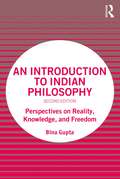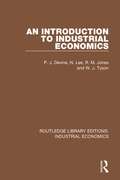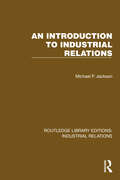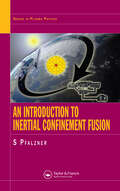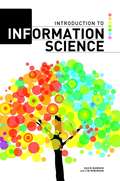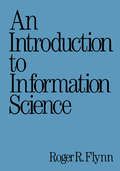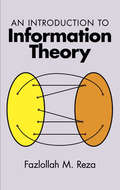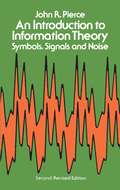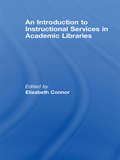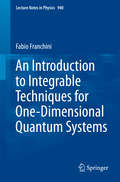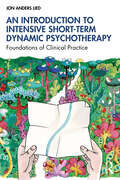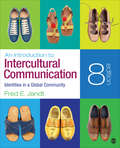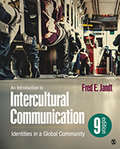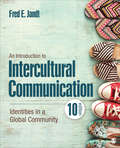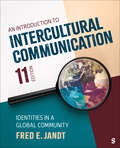- Table View
- List View
An Introduction to Indian Philosophy: Perspectives on Reality, Knowledge, and Freedom
by Bina GuptaAn Introduction to Indian Philosophy offers a profound yet accessible survey of the development of India’s philosophical tradition. Beginning with the formation of Brahmanical, Jaina, Materialist, and Buddhist traditions, Bina Gupta guides the reader through the classical schools of Indian thought, culminating in a look at how these traditions inform Indian philosophy and society in modern times. Offering translations from source texts and clear explanations of philosophical terms, this text provides a rigorous overview of Indian philosophical contributions to epistemology, metaphysics, philosophy of language, and ethics. This is a must-read for anyone seeking a reliable and illuminating introduction to Indian philosophy.
An Introduction to Indian Philosophy: Perspectives on Reality, Knowledge, and Freedom
by Bina GuptaAn Introduction to Indian Philosophy offers a profound yet accessible survey of the development of India’s philosophical tradition. Beginning with the formation of Brāhmaṇical, Jaina, Materialist, and Buddhist traditions, Bina Gupta guides the reader through the classical schools of Indian thought, culminating in a look at how these traditions inform Indian philosophy and society in modern times. Offering translations from source texts and clear explanations of philosophical terms, this text provides a rigorous overview of Indian philosophical contributions to epistemology, metaphysics, philosophy of language, and ethics. This is a must-read for anyone seeking a reliable and illuminating introduction to Indian philosophy. Key Updates in the Second Edition Reorganized into seven parts and fifteen chapters, making it easier for instructors to assign chapters for a semester-long course. Continues to introduce systems historically, but focuses on new key questions and issues within each system. Details new arguments, counter-arguments, objections, and their reformulations in the nine schools of Indian philosophy. Offers expanded discussion of how various schools of Indian philosophy are engaged with each other. Highlights key concepts and adds new grey boxes to explain selected key concepts. Includes a new section that problematizes the Western notion of "philosophy." New Suggested Readings sections are placed at the end of each chapter, which include recommended translations, a bibliography of important works, and pertinent recent scholarship for each school. Adds a new part (Part III) that explains the difficulties involved in translating from Sanskrit into English, discusses fundamental concepts and conceptual distinctions often used to present Indian philosophy to Western students, and reviews important features and maxims that most darśanas follow. Provides new examples of applications to illustrate more obscure concepts and principles.
An Introduction to Indigenous Feminisms
by Isabel Altamirano-Jiménez Sarah Nickel Hōkūlani K. Aikau waaseyaa’sin Christine SyAn Introduction to Indigenous Feminisms introduces important concepts and approaches for understanding what Indigenous feminisms are, why we use the term in plural, and why Indigenous feminisms are not just for academics.This engaging and accessible textbook, the first of its kind in this subject, provides instructors and students with the historical contexts, analytical tools, and the practice-driven possibilities for creative and epistemic engagement with Indigenous feminist knowledge. Besides including useful pedagogical features, the volume explores: How Indigenous feminist conversations have evolved What political practices have developed over time Stories, theories, and histories about Indigenous women’s experiences An Introduction to Indigenous Feminisms provides students with ways to practice Indigenous ways of thinking, learning, especially those studying Gender Studies, Social and Cultural History, Sociology and Politics.
An Introduction to Industrial Economics (Routledge Library Editions: Industrial Economics #14)
by N. Lee P.J. Devine R.M. Jones W.J. TysonThis updated and expanded 1985 edition of the classic 1974 work covers deindustrialisation, industrial and competition policy, the public enterprise sector, regional and urban policy, and privatisation, as well as focussing on the firm and the industrial sector in all its facets. It remains the key work on industrial economics.
An Introduction to Industrial Relations (Routledge Library Editions: Industrial Relations)
by Michael P. JacksonAn Introduction to Industrial Relations (1991) analyses various theoretical approaches to industrial relations, and summarises the origins and development of the subject. It looks at the impact of legislative changes, technological developments and the growing currency of ‘human resource management’ theories. The book offers a comparative approach, making extensive use of material from outside the UK, notably from America, Europe and the Pacific Rim, and examines the implications of EEC legislation for industrial relations in the 1990s.
An Introduction to Industrial Service Design
by Satu MiettinenService design has established itself as a practice that enables industries to design and deliver their services with a human-centred approach. It creates a contextual and cultural understanding that offers opportunities for new service solutions, improving the user experience and customer satisfaction. With contributions from leading names in the field of service design from both academia and international, professional practice, An Introduction to Industrial Service Design is engaging yet practical and accessible. Case studies from leading companies such as ABB, Autodesk, Kone and Volkswagen enable readers to connect academic research with practical company applications, helping them to understand the basic processes and essential concepts. This book illustrates the role of the service designer in an industrial company, and highlights not only the value of customer experience, but also the value of employee experience in creating competitive services and value propositions. This human-centred approach brings about new innovations. This book will be of benefit to engineers, designers, businesses and communication experts working in industry, as well as to students who are interested in service development.
An Introduction to Inertial Confinement Fusion
by Susanne PfalznerNewcomers to the field of inertial confinement fusion (ICF) often have difficulty establishing a clear picture of the overall field. The reason for this is because, while there are many books devoted to special topics within the field, there is none that provides an overview of the field as a whole. An Introduction to Inertial Confinement Fusion fi
An Introduction to Information Design
by Kathryn Coates Andy EllisonInformation design is the visualization of information through graphic design. This invaluable guide provides a creative, informative, and practical introduction to the general principles of information design. With chapters on understanding the audience, structure, legibility and readability, selection of media, experimentation, and multi-platform delivery, An Introduction to Information Design gives a complete overview of this fundamental aspect of visual communication. Fully illustrated case studies from leading designers provide professional insight into the challenges involved in creating information design for print, interactive, and environmental media. Practical exercises and tips enable the reader to put this learning into practice. This makes it the perfect book for graphic design students as well as design enthusiasts.
An Introduction to Information Design
by Kathryn CoatesInformation design is the visualization of information through graphic design. This invaluable guide provides a creative, informative, and practical introduction to the general principles of information design. With chapters on understanding the audience, structure, legibility and readability, selection of media, experimentation, and multi-platform delivery, An Introduction to Information Design gives a complete overview of this fundamental aspect of visual communication. Fully illustrated case studies from leading designers provide professional insight into the challenges involved in creating information design for print, interactive, and environmental media. Practical exercises and tips enable the reader to put this learning into practice. This makes it the perfect book for graphic design students as well as design enthusiasts.
An Introduction to Information Science
by David Bawden Lyn RobinsonOffers an overview and outline of the important concepts and ideas in information science and librarianship. Among the critical topics covered: Foundations, including the information society, historical perspectives and concepts ; Organizing and retrieving information ; Information behavior and digital literacies ; Technologies and digital libraries ; Information research and methods ; Changing contexts including publishing, e-science and digital humanities ; The future of the profession.
An Introduction to Information Science
by Roger FlynnThis book comprises an introduction to information as an external commodity; a data base that can be manipulated, retrieved, transmitted, and used. It is useful at an introductory undergraduate level and also for anyone who is new to the field of Information Science.
An Introduction to Information Security and ISO27001
by Steve G WatkinsThis book furnishes readers with an understanding of the basics of information security, including: a definition of what information security means; how managing information security can be achieved using an approach recognized world-wide; the sorts of factors that need to be considered in an information security regime, including how the perimeters of such a scheme can be properly defined; how an information security management system can ensure it is maximizing the effect of any budget it has; what sort of things resources might be invested in to deliver a consistent level of assurance; and how organizations can demonstrate the degree of assurance they offer with regards to information security, how to interpret claims of adherence to the ISO 27001 standard and exactly what it means. Corporate bodies will find this book useful at a number of stages in any information security project, including at the decision-making stage, at project initiation stage, and as part of an on-going awareness campaign.
An Introduction to Information Theory (Dover Books on Mathematics)
by Fazlollah M. RezaWritten for an engineering audience, this book has a threefold purpose: (1) to present elements of modern probability theory — discrete, continuous, and stochastic; (2) to present elements of information theory with emphasis on its basic roots in probability theory; and (3) to present elements of coding theory.The emphasis throughout the book is on such basic concepts as sets, the probability measure associated with sets, sample space, random variables, information measure, and capacity. These concepts proceed from set theory to probability theory and then to information and coding theories. No formal prerequisites are required other than the usual undergraduate mathematics included in an engineering or science program. However, since these programs may not include a course in probability, the author presents an introductory treatment of probability for those who wish to pursue the general study of statistical theory of communications. The book is divided into four parts: memoryless discrete themes, memoryless continuum, schemes with memory, and an outline of some recent developments. An appendix contains notes to help familiarize the reader with the literature in the field, while the inclusion of many reference tables and an extensive bibliography with some 200 entries makes this an excellent resource for any student in the field.
An Introduction to Information Theory: Symbols, Signals and Noise
by John R. PierceBehind the familiar surfaces of the telephone, radio, and television lies a sophisticated and intriguing body of knowledge known as information theory. This is the theory that has permeated the rapid development of all sorts of communication, from color television to the clear transmission of photographs from the vicinity of Jupiter. Even more revolutionary progress is expected in the future.To give a solid introduction to this burgeoning field, J. R. Pierce has revised his well-received 1961 study of information theory for an up-to-date second edition. Beginning with the origins of the field, Dr. Pierce follows the brilliant formulations of Claude Shannon and describes such aspects of the subject as encoding and binary digits, entropy. language and meaning, efficient encoding , and the noisy channel. He then goes beyond the strict confines of the topic to explore the ways in which information theory relates to physics, cybernetics, psychology, and art. Mathematical formulas are introduced at the appropriate points for the benefit of serious students. A glossary of terms and an appendix on mathematical notation are provided to help the less mathematically sophisticated.J. R. Pierce worked for many years at the Bell Telephone Laboratories, where he became Director of Research in Communications Principles. He is currently affiliated with the engineering department of the California Institute of Technology. While his background is impeccable, Dr. Pierce also possesses an engaging writing style that makes his book all the more welcome. An Introduction to Information Theory continues to be the most impressive non-technical account available and a fascinating introduction to the subject for laymen."An uncommonly good study. . . . Pierce's volume presents the most satisfying discussion to be found."- Scientific American.
An Introduction to Instructional Services in Academic Libraries
by Elizabeth ConnorMore than ever before, librarians are being called upon to contribute considerable energy, knowledge, and leadership to fostering the academic success of students through information literacy. Unique in its expansive breadth and in-depth approach, An Introduction to Instructional Services in Academic Libraries explores the latest methods and ideas for planning, delivering, and evaluating effective instructional sessions. Providing librarians with informative, real-world case studies culled from over three dozen prominent librarian-instructors from across the US and Canada, An Introduction to Instructional Services in Academic Libraries comprehensively covers the topics of experiential learning, hybrid models of library instruction, interdisciplinary inquiry through collaboration, introducing primary documents to undergrads, using case studies in credit-bearing library courses, teaching information literacy to ESL students, information literature for the non-traditional student, preparing an advanced curriculum for graduate students, librarians in the online classroom, and teaching distance education students. An Introduction to Instructional Services in Academic Libraries features numerous planning documents, survey instruments, handouts, active learning exercises, and extensive references which make it an ideal resource for educators and librarians everywhere.
An Introduction to Integrable Techniques for One-Dimensional Quantum Systems (Lecture Notes in Physics #940)
by Fabio FranchiniThis book introduces the reader to basic notions of integrable techniques for one-dimensional quantum systems. In a pedagogical way, a few examples of exactly solvable models are worked out to go from the coordinate approach to the Algebraic Bethe Ansatz, with some discussion on the finite temperature thermodynamics. The aim is to provide the instruments to approach more advanced books or to allow for a critical reading of research articles and the extraction of useful information from them. We describe the solution of the anisotropic XY spin chain; of the Lieb-Liniger model of bosons with contact interaction at zero and finite temperature; and of the XXZ spin chain, first in the coordinate and then in the algebraic approach. To establish the connection between the latter and the solution of two dimensional classical models, we also introduce and solve the 6-vertex model. Finally, the low energy physics of these integrable models is mapped into the corresponding conformal field theory. Through its style and the choice of topics, this book tries to touch all fundamental ideas behind integrability and is meant for students and researchers interested either in an introduction to later delve in the advance aspects of Bethe Ansatz or in an overview of the topic for broadening their culture.
An Introduction to Intensive Short-Term Dynamic Psychotherapy: Foundations of Clinical Practice
by Jon Anders LiedThis book offers a comprehensive introduction to Intensive Short-Term Dynamic Psychotherapy (ISTDP), covering its theoretical foundations, core techniques, and practical applications.The author first introduces six key psychodynamic concepts essential for ISTDP in an accessible, jargon-free way, then shifts focus to building strong conscious therapeutic alliances. Finally, core ISTDP techniques are clearly explained and demonstrated. Through clinical examples and real therapy transcripts, this book illustrates how to effectively integrate ISTDP to resolve unconscious conflicts by addressing feelings, anxiety, and defenses.Whether you are a student or a beginner therapist new to ISTDP, or an experienced practitioner looking to revisit the fundamentals of this exciting method, this book serves as an accessible, relevant, and indispensable resource.
An Introduction to Interaction: Understanding Talk in the Workplace and Everyday Life
by Angela Cora GarciaAn engaging introduction to the study of spoken interaction, this book provides a thorough grounding in the theory and methodology of conversation analysis. It covers data collection, techniques for analysis and practical applications, and guides students through foundational and new research findings on everyday conversations and talk in institutional contexts, from media, business, and education to healthcare and law. <p><p>Now thoroughly updated to showcase contemporary developments in the field, this second edition includes: <p>• New chapters on interaction in psychotherapy, educational settings and language learning and teaching <p>• Expanded coverage of doctor-patient communications, customer service and business meetings workplace interviews and online interactions, including social media, video gaming and livestreams <p>• A wider variety of research on other languages, including French, German, Italian, Finnish, Swedish, Arabic, Korean, Chinese and Japanese <p>• Multimodal analyses of interaction, focusing on the integration of embodied action and talk <p><p>Complete with student activities, recommended reading sections and a companion website featuring slides, quiz questions, and links to further transcripts, this book is an essential guide for doing conversation analysis and offers fresh insight into how we understand talk.
An Introduction to Intercultural Communication: Identities in a Global Community
by Fred E. JandtAn Introduction to Intercultural Communication: Identities in a Global Community prepares today’s students to successfully navigate our increasingly global community. Fred E. Jandt introduces essential communication skills and concepts that will empower readers to interact successfully with different cultures and ethnic groups. To spark student interest, Jandt offers readers unique insights into intercultural communication, at home and abroad, through an emphasis on history, culture, and popular media. Each chapter integrates material on social media, as well as extensive new examples from recent international news and events. Throughout the text, Jandt reinforces the important roles that stories, personal experiences, and self-reflection play in building our intercultural understanding and competence. The Eighth Edition adds depth to the coverage of theory and includes two new features: Focus on Skills provides expanded coverage of intercultural communication in practice, while Focus on Technology illustrates the impact of new communication technology on intercultural encounters. The new edition also introduces a new map program to provide students with additional context for discussion of cultures and regions across the globe.
An Introduction to Intercultural Communication: Identities in a Global Community
by Fred E. Jandt“One of the best textbooks in intercultural communication for undergraduate students” —Mo Bahk, California State University, San Bernardino How does the Syrian refugee crisis, the election of Donald Trump, and the increasing number of “walls” being built to control immigration affect our ability to communicate and function across cultures? The highly anticipated Ninth Edition of An Introduction to Intercultural Communication prepares today’s students to successfully navigate our increasingly global community by integrating major current events into essential communication skills and concepts. To spark student interest, award-winning professor and best-selling author Fred E. Jandt offers unique insights into intercultural communication, at home and abroad, through an emphasis on history, culture, and popular media. Each chapter integrates material on social media, as well as extensive new examples from recent international news and events. Throughout the text, Jandt reinforces the important roles that our own stories, personal experiences, and self-reflection play in building our intercultural understanding and competence. New to the Ninth Edition New material on religion and identity, gender identity, and gender expression enables readers to explore the most current coverage on modern theories. Focus on Skills boxes have been expanded to include more activities that provide students with additional practice of intercultural communication skills. Focus on Technology boxes illustrate the impact of the newest communication technology on intercultural encounters. The popular map program provide students with additional context for discussion of cultures and regions across the globe and dynamic data displays that are popular with students. Give your students the SAGE edge! SAGE edge offers a robust online environment featuring an impressive array of free tools and resources for review, study, and further exploration, keeping both instructors and students on the cutting edge of teaching and learning. Learn more at edge.sagepub.com/jandt9e
An Introduction to Intercultural Communication: Identities in a Global Community
by Fred E. Jandt“One of the best textbooks in intercultural communication for undergraduate students” —Mo Bahk, California State University, San Bernardino How does the Syrian refugee crisis, the election of Donald Trump, and the increasing number of “walls” being built to control immigration affect our ability to communicate and function across cultures? The highly anticipated Ninth Edition of An Introduction to Intercultural Communication prepares today’s students to successfully navigate our increasingly global community by integrating major current events into essential communication skills and concepts. To spark student interest, award-winning professor and best-selling author Fred E. Jandt offers unique insights into intercultural communication, at home and abroad, through an emphasis on history, culture, and popular media. Each chapter integrates material on social media, as well as extensive new examples from recent international news and events. Throughout the text, Jandt reinforces the important roles that our own stories, personal experiences, and self-reflection play in building our intercultural understanding and competence. New to the Ninth Edition New material on religion and identity, gender identity, and gender expression enables readers to explore the most current coverage on modern theories. Focus on Skills boxes have been expanded to include more activities that provide students with additional practice of intercultural communication skills. Focus on Technology boxes illustrate the impact of the newest communication technology on intercultural encounters. The popular map program provide students with additional context for discussion of cultures and regions across the globe and dynamic data displays that are popular with students. Give your students the SAGE edge! SAGE edge offers a robust online environment featuring an impressive array of free tools and resources for review, study, and further exploration, keeping both instructors and students on the cutting edge of teaching and learning. Learn more at edge.sagepub.com/jandt9e
An Introduction to Intercultural Communication: Identities in a Global Community
by Fred E. JandtAn Introduction to Intercultural Communication equips students with the knowledge and skills to be competent and confident intercultural communicators. Best-selling author Fred E. Jandt guides readers through key concepts and helps them connect intercultural competence to their own life experiences in order to enhance understanding. Employing his signature accessible writing style, Jandt presents balanced, up-to-date content in a way that readers find interesting and thought-provoking. The Tenth Edition gives increased attention to contemporary social issues in today’s global community such as gender identifications, social class identity, and immigration and refugees. Included with this title: The password-protected Instructor Resource Site (formally known as SAGE Edge) offers access to all text-specific resources, including a test bank and editable, chapter-specific PowerPoint® slides.
An Introduction to Intercultural Communication: Identities in a Global Community
by Fred E. JandtAn Introduction to Intercultural Communication equips students with the knowledge and skills to be competent and confident intercultural communicators. Best-selling author Fred E. Jandt guides readers through key concepts and helps them connect intercultural competence to their own life experiences in order to enhance understanding. Employing his signature accessible writing style, Jandt presents balanced, up-to-date content in a way that readers find interesting and thought-provoking. The Tenth Edition gives increased attention to contemporary social issues in today’s global community such as gender identifications, social class identity, and immigration and refugees. Included with this title: The password-protected Instructor Resource Site (formally known as SAGE Edge) offers access to all text-specific resources, including a test bank and editable, chapter-specific PowerPoint® slides.
An Introduction to Intercultural Communication: Identities in a Global Community
by Fred E. JandtAn Introduction to Intercultural Communication prepares students to successfully navigate our increasingly interconnected global community by introducing essential communication skills and concepts with the goal of cultivating intercultural communication competencies when interacting with different cultures and ethnic groups. Best-selling author Fred E. Jandt offers students unique insights into intercultural communication, at home and abroad, through a focus on history, culture, and popular media. Emphasis is also placed on the important roles that stories, personal experiences, and self-reflection play in building our intercultural understanding and competence. The Eleventh Edition presents the most extensive revision of the text, including tying chapter learning objectives to the content, a new "Point/Counterpoint" feature to present both sides of controversial issues in intercultural communication to aid in developing critical thinking skills, and current examples that speak to the changing dynamics of our global community.
An Introduction to Intercultural Communication: Identities in a Global Community
by Fred E. JandtAn Introduction to Intercultural Communication prepares students to successfully navigate our increasingly interconnected global community by introducing essential communication skills and concepts with the goal of cultivating intercultural communication competencies when interacting with different cultures and ethnic groups. Best-selling author Fred E. Jandt offers students unique insights into intercultural communication, at home and abroad, through a focus on history, culture, and popular media. Emphasis is also placed on the important roles that stories, personal experiences, and self-reflection play in building our intercultural understanding and competence. The Eleventh Edition presents the most extensive revision of the text, including tying chapter learning objectives to the content, a new "Point/Counterpoint" feature to present both sides of controversial issues in intercultural communication to aid in developing critical thinking skills, and current examples that speak to the changing dynamics of our global community.

